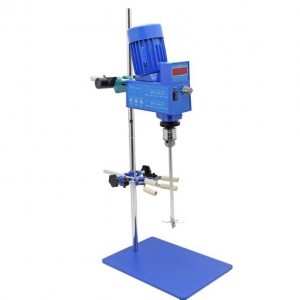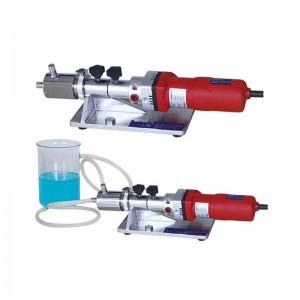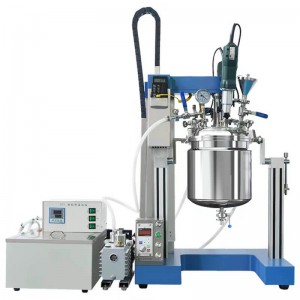laboratory homogenizer Lab Homogenizer
PRODUCT DETAIL

Laboratory homogenizers are used to mix, emulsify, disintegrate, and/or deagglomerate substances. The features of laboratory homogenizer include:
1. Variable speed control: laboratory homogenize has a variable speed control to allow the user to adjust the speed according to the sample type and the desired mixing intensity.
2. High-performance motor:laboratory homogenize features a high-performance motor that delivers consistent and efficient mixing for various applications.
3. Easy to clean: laboratory homogenize is designed for easy cleaning and maintenance, which is essential to prevent contamination and ensure accuracy of the results.
4. Safety features: The homogenizer is equipped with safety features such as overload protection, overheat protection, and a safety switch that prevents operation when the motor is not correctly attached to the probe.
5. User-friendly design: Lab Homogenizer is designed to be user-friendly, with easy-to-read controls and displays that allow for accurate parameter settings and monitoring.
When using laboratory homogenizer , the following basic safety measures such as electric shock, fire risk, personal injury and so on must be followed:
Power supply must be cut off before cleaning, maintenance, maintenance or any other related operation.
In order to avoid electric shock danger, do not contact other parts of the dispersed knife head with working materials.
laboratory homogenizer shall not be operated after failure or damage.
In order to prevent electric shock, non-related professionals may not open the shell of the equipment without authorization.
Under working condition, it is recommended to wear hearing protection device.
laboratory homogenizer high shear dispersing emulsifier, by high speed rotating rotor and precise stator working cavity, relying on high linear speed, produce strong hydraulic shear, centrifugal extrusion, high speed cutting and collision, so that the material is fully dispersed, emulsified, Homogenize, comminute, mix, and finally get stable high-quality products.
Lab Homogenizer is widely used in pharmaceutical, biochemical, food, nano-materials, coatings, adhesives, daily chemicals, printing and dyeing, petrochemical, papermaking chemistry, polyurethane, inorganic salts, bitumen, organosilicon, pesticides, water treatment, heavy oil emulsification and other industries.
technical parameter

3.1 Motor
Input power: 500W
Output power: 300W
Frequency: 50 / 60HZ
Rated voltage: AC / 220V
Speed range: 300-11000rpm
Noise: 79dB
working head
Stator diameter: 70 mm
Total length: 260mm
Impregnable material depth: 200mm
Suitable volume: 200-40000ml / h _ 2O)
Applicable viscosity: < 5000cp
Working temperature: < 120 ℃
Lab Homogenizer speed setup

1. Speed regulation adopts governor mode. The machine should be used for a period of time or for a longer period of time. Maintenance inspection should be carried out before re-use, especially in the electrical safety performance, mega meter can be used to detect insulation resistance.
2. The working head is made of high quality stainless steel and the casing is made of high quality engineering plastic injection molding assemble
3. fasten the shaft to the bottom plate with nuts.
4. fasten the bar to the motor
5. fasten the mainframe to the work frame by means of fixture
6.stator replacement steps: first use a wrench (randomly attached), unscrew three M5 nuts, remove the outer stator, remove the unsuitable inner stator, then put the appropriate stator on the positioning step, then install the outer stator ring, The three M5 nuts should be synchronized and slightly tightened, and the rotor shaft should not be loosened periodically.
6, use of Lab Homogenizer
7. Lab Homogenizer must operate in the working medium, do not operate empty machine, otherwise it will damage the sliding bearing.
8. since the rotor has suction force, the distance between the head and the bottom of the container should not be less than 20mm. It is better to place the dispersed head slightly eccentric, which is more conducive to the medium turning.
9. Lab Homogenizer adopts single - phase, and the required power supply socket is 220V50HZ , 10A three - hole socket , and the socket must have good grounding . Be careful not to connect the fault , and the grounding wire ( it is not allowed to lead the grounding wire to the telephone line , water pipe , gas pipe and lightning rod ) . Before starting , check whether the circuit voltage matches the voltage requirements of the machine , and the socket must be grounded . Check the container for hard objects such as impurities .
10.before turning on the power supply, the power switch must be in the disconnection position, then turn on the switch and start driving at the lowest speed, slowly increasing the speed until the desired speed. If the material viscosity or solid content is high, the electronic speed regulator will automatically reduce the rotational speed, at this time, the capacity of the working material should be reduced
11 the recommended feeding process is to first add a liquid with low viscosity, start work, then add a liquid with high viscosity, and finally, add the solid material evenly.
12 when working medium temperature is higher than 40 ℃ or corrosive medium, take appropriate precautions.
13. the brush on the motor of Lab Homogenizer is easily damaged and should be inspected frequently by the user. During inspection, please cut off the power supply, pull out the plug, spin down the brush cap / cover and pull out the brush. If it is found that the brush is shorter than 6MM, it should be replaced in time. The new brush should use the original brush, and should move freely in the brush tube (frame), so as to prevent the stuck in the tube, resulting in the large electric spark or the non-running of the motor.
14. Cleaning for Lab Homogenizer
After the scattered head has been overworked, it must be cleaned.
Cleaning methods:
For easy cleaning materials, add proper detergent in the container, let the dispersing head rotate quickly for 5 minutes, then rinse with water and wipe the soft cloth.
For difficult to clean materials, it is recommended to use solvent cleaning, but should not be soaked in corrosive solvents for a long time.
For applications in aseptic industries such as biochemical, pharmaceutical, food and other aseptic requirements, the dispersed head shall be removed and cleaned and sterilized.
Products categories
-

E-mail
-

Phone
-

Top

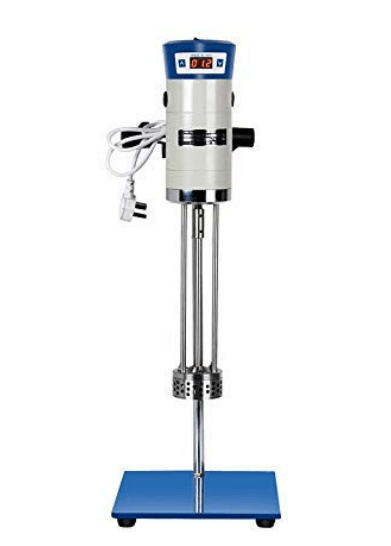
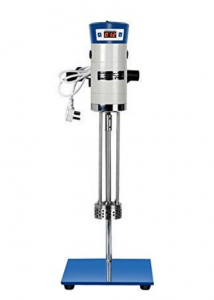
 0086 15800211936
0086 15800211936